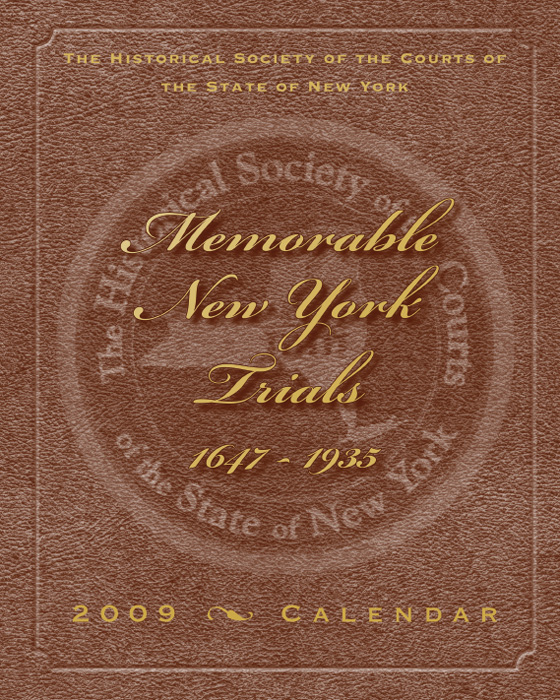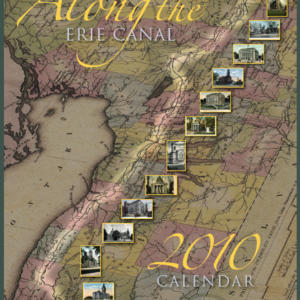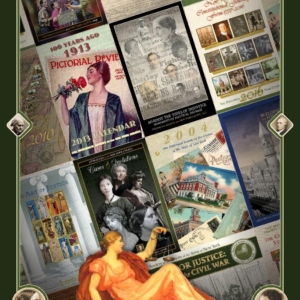Description
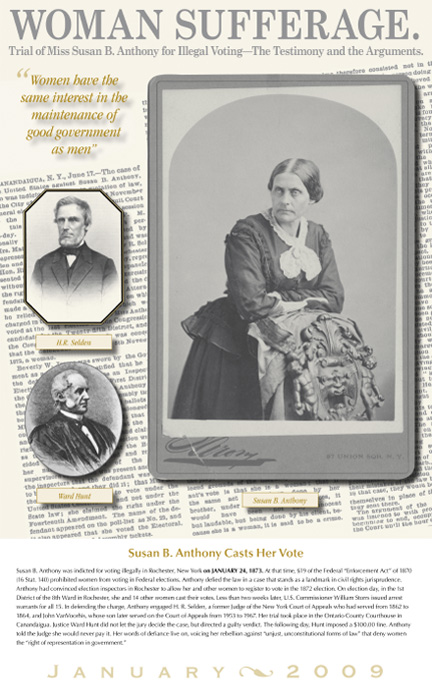
Susan B. Anthony Casts Her Vote
February 2009
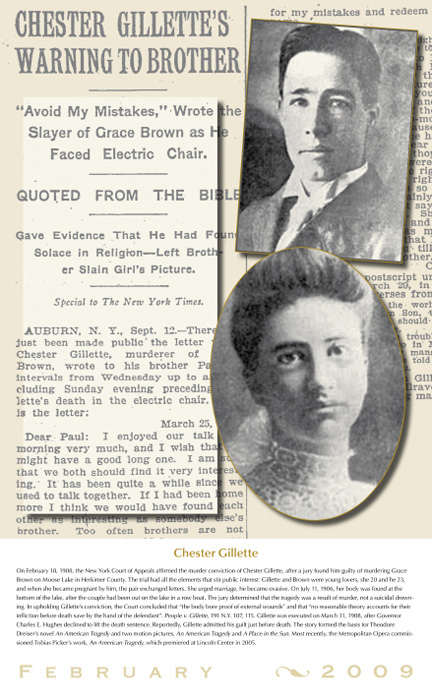
Chester Gillette
On February 18, 1908, the New York Court of Appeals affirmed the murder conviction of Chester Gillette, after a jury found him guilty of murdering Grace Brown on Moose Lake in Herkimer County. The trial had all the elements that stir public interest: Gillette and Brown were young lovers, she 20 and he 23and when she became pregnant by him, the pair exchanged letters. She urged marriage, he became evasive. On July 11, 1906, her body was found at the bottom of the lake, after the couple had been out on the lake in a row boat. The jury determined that the tragedy was a result of murder, not a suicidal drowning. In upholding Gillette’s conviction the Court concluded that ‘the body bore proof of external wounds’ and that ‘no reasonable theory accounts for their infliction before death save by the hand of the defendant.’ People v. Gillette, 191 N.Y. 107, 115. Gillette was executed on March 31, 1908, after Governor Charles E. Hughes declined to lift the death sentence. Reportedly, Gillette admitted his guilt just before death. The story formed the basis for Theodore Dreiser’s novel An American Tragedy and two motion pictures, An American Tragedy and A Place in the Sun. Most recently, the Metropolitan Opera commissioned Tobias Picker’s work, An American Tragedy, which premiered at Lincoln Center in 2005.
March 2009

William “Boss” Tweed
William ‘Boss’ Tweed, one of the most corrupt officials in the annals of American history, was finally brought to justice when a jury convicted him of neglect of duty. On March 22, 1875, the New York Court of Appeals heard the appeal from the 12-year sentence imposed upon Tweed by Judge Noah Davis. A larger-than-life figure who made a career of graft in public lice, Tweed has escaped justice in an earlier trial that resulted in a hung jury. Following the first trial. Tweed proclaimed ‘time works wonders, say, and it will a change in this. I guess I shall live it all down.’ Tweed, however, was convicted at his second trial, after the jury, on November 19, 1873, found him guilty of 204 misdemeanors. The prosecution sought consecutive sentences that would have tallied up to over a hundred years behind bars. Agreeing in part, Judge Davis grouped certain counts together and imposed 12 one-year sentences to be served consecutively. The Court of Appeals, however, ruled that consecutive sentences were illegal and granted Tweed’s writ of habeas corpus, limiting the sentence to one year. People ex rel. Tweed v. Liscomb 60 N.Y. 559 (1875). Other charges and indictments shadowed him, and while at the Ludlow Street Jail awaiting trial, Twee escaped in December, 1875 and fled to Cuba and then Spain, where he was arrested several months later. He died in debt.
April 2009
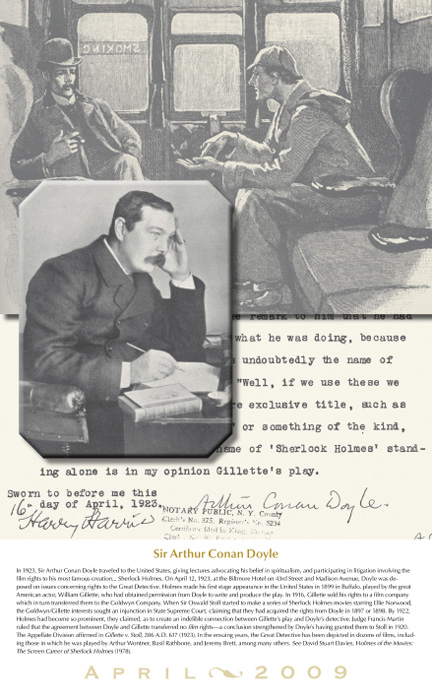
Sir Arthur Conan Doyle
In 1923, Sir Arthur Conan Doyle traveled to the United States, giving lectures advocating his belief in spiritualism, and participating in litigation involving the film rights to his most famous creation…Sherlock Holmes. On April 12, 1923, at the Biltmore Hotel on 43rd Street and Madison Avenue, Doyle was deposed on issues concerning rights to the Great Detective. Holmes made his first stage appearance in the United States in 1899 in Buffalo, played by the great American Actor, William Giullette, who had obtained permission from Doytle to write and produce the play. In 1916, Gillette sold his rights to a film company which in turn transferred them to the Goldwyn Company. Whin Sir Oswald Stoll started to make a series of Sherlock Holmes movies starring Ellie Norwood, the Goldwyn/Gillette interests sought an injunction in State Supreme Court, claiming that they had acquired the rights from Doyle in 1897 or 1898. By 1922, Holmes had become sp prominent, they claimed, as to create an indelible connection between Gillette’a play and Doyle’s detective. Judge Francis Marin riled that the agreement between Doyle and Gillette transferred no film rights-a conclusion strengthened by Doyle’s having granted them to Stoll in 1920. The Appellate Division affirmed Gillette v. Stoll, 206 A.D. 617 (1923). In the ensuing years, the Great Detective has been depicted in dozens of films, including those in which he was played by Arthur Wontner, Basil Rathbone, and Jeremy Brett ,among many others. See David Stuart Davies, Holmes of the Movies: The Screen Career of Sherlock Holmes (1978).
May 2009
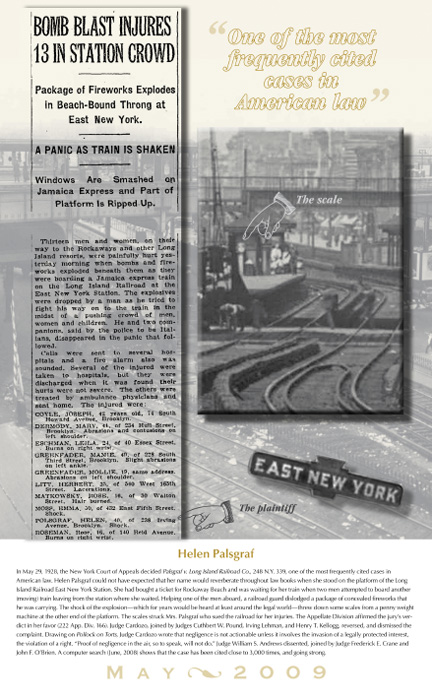
Helen Palsgraf
On May 29, 1928, the New York Court of Appeals decided Palsgraf v Long Island Railroad Co. 248 N.Y. 339, one of the most frequently cited cases in American law. Helen Palsgraf could not have expected that her name would reverberate throughout law books when she stood on the platform of the Long Island Railroad East New York Station. She had bought a ticket for Rockaway Beach and was waiting for her train when two men attempted to board another (moving) train leaving from the station where she waited. Helping one of the men aboard, a railroad guard dislodged a package of concealed fireworks that he was carrying. The shock of the explosion-which for years would be heard at least around the legal world-threw down some scales from a penny weight machine at the other end of the platform. The scales struck Mrs. Palsgraf who sued the railroad for her injuries. The Appellate Division affirmed the jury’s verdict in her favor (222 App. Div. 166). Judge Cardozo, joined by Judges Cuthbert W. Pound, Irving Lehman, and Henry T. Kellogg, reversed, and dismissed the complaint. Draing on Pollock on Torts, Judge Cardozo wrote the negligence is not actionable unless it involves the invasion of a legally protected interest, the violation of a right. ‘Proof of negligence in the air, so to speak, will not do.’ Judge William S. Andrews dissented, joined by Judge Frederick E. Crane and John F. O’Brien. A computer search (June, 2008) chows that the case has been cited close to 3,000 times and is going strong.
June 2009
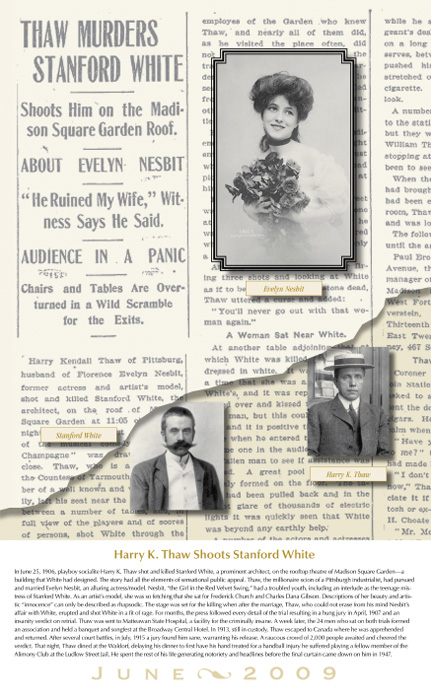
Harry K. Thaw Shoots Stanford White
On June 25, 1906 playboy socialite Harry K. Thaw shot and killed Stanford White, a prominent architect, on the rooftop theatre of Madison Square Garden-a building that White had designed. The story had all the elements of sensational public appeal. Thaw, the millionaire scion of a Pittsburgh industrialist, had pursued and married Evelyn Nesbit, an alluring actress/model. Nesbit, ‘the Girl in the Red Velvet Swing,’ had a troubled youth, including an interlude as the teenage mistress of Stanford White. As an artist’s model, she was so fetching that she sat for Frederick Church and Charles Dana Gibson. Descriptions of her beauty and artistic ‘innocence’ can only be described as rhapsodic. The state was set for the killing when after the marriage, Thaw, who could not erase from his mind Nesbit’s affair with White, erupted and shot White in a fit of rage. For months, the press followed every detail of the trial resulting in a hung jury in April, 1907 and an insanity verdict on retrial. Thaw was sent to Matteawan State Hospital, a facility for the criminally insane. A week later, the 24 men who sat on both trials formed an association and held a banquet and songfest at the Broadway Central Hotel. In 1913, still in custody, Thaw escaped to Canada where we was apprehended and returned. After several court battles, in July, 1915, a jury found him sane, warranting his release. A raucous crowd of 2,000 people awaited and cheered the verdict. That night, Thaw dined at the Waldorf, delaying his dinner to first have his hand treated for a handball injury he suffered playing a fellow member of the Alimony Club at the Ludlow Street Jail. He spent the rest of his life generating notoriety and headlines before the final curtain came down on him in 1947.
July 2009
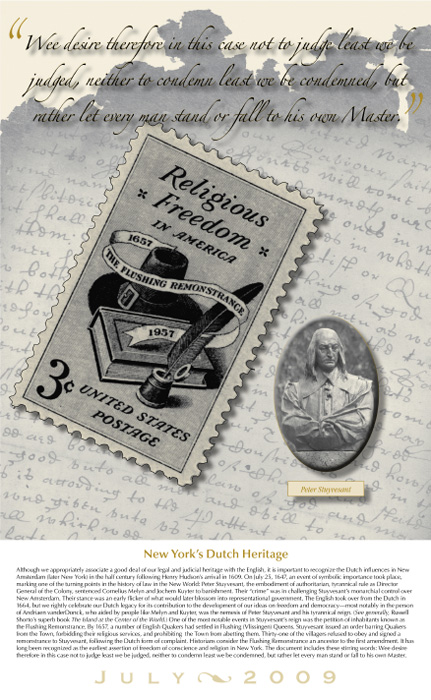
New York’s Dutch Heritage
Although we appropriately associate a good deal of our legal and judicial heritage with the English, it is important to recognize the Dutch influences in New Amsterdam (later New York) in the half century following Henry Hudson’s arrival in 1609. On July 25, 1647, an event of symbolic importance took place, marking one of the turning points in the history of law in the New World: Peter Stuyvesant, the embodiment of authoritarian, tyrannical rule as Director General of the Colony, sentenced Cornelius Melyn and Jochem Kuyter to banishment. Their ‘crime’ was in challenging Stuyvesant’s monarchial control over New Amsterdam. Their stance was an early flicker of what would later blossom into representaional government. The English took over from the Dutch in 1664, but we rightly celebrate our Dutch legacy for its contribution to the development of our ideas on freedom and democracy-most notably in the person of Andriaen van der Donck, who aided by people like Melyn and Kuyer, was the nemesis of Peter Stuyvesant and his tyrannical reign. (See generally, Russell Shorto’s superb book The Island at the Center of the World.) One of the most notable events in Stuyvesant’s reign was the petition of inhabitants known as the Flushing Remonstrance. By 1657, a number of English Quakers had settled in Flushing (Vlissingen) Queens. Stuyvesant issued an order barring Quakers from the Town, forbidding their religious services, and prohibiting the Town from abetting them. Thirty-one of the villagers refused to obey and signed a remonstrance to Stuyvesant, following the Dutch form of complaint. Historians consider the Flushing Remonstrance an ancestor to the first amendment. It has long been recognized as the earliest assertion of freedom of conscience and religion in New York. The document included these stirring words: Wee desire therefore in this case not to judge least we be judged, neither to condemn least we be condemned, but rather let every man stand or fall to his own Master.
August 2009
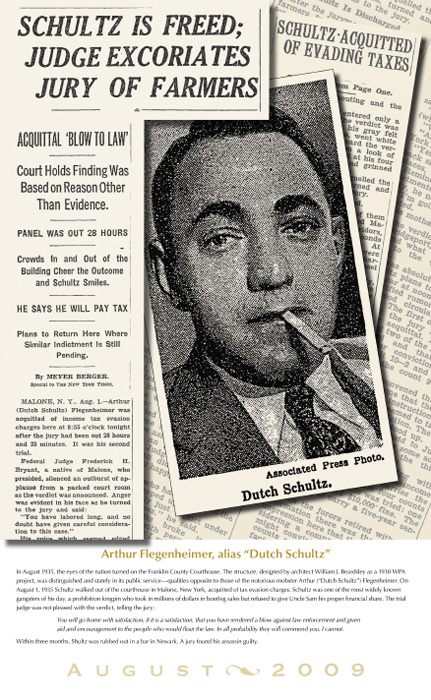
Arthur Flegenheimer, Alias “Dutch Schultz”
In August 1935, the eyes of the nation turned on the Franklin County Courthouse. The structure, designed by architect William J. Beardsley as a 1930 WPA project, was distinguished and stately in its public service-qualities opposite to those of the notorious mobster Arthur (‘Dutch Schultz’) Flegenheimer. On August 1, 1935 Shultz walked our of the courthouse in Malone, New York, acquitted of tax evasion charges. Schultz was one of the most widely known gangsters of his day, a prohibition kingpin who took in millions of dollars in bootleg sales but refused to give Uncle Sam his proper financial share. The trial judge was not please with the verdict, telling the jury:
You will go home with satisfaction, if it is a satisfaction, that you have rendered a blow against law enforcement and given aid and encouragement to the people who would flout the law. In all probability they will commend you. I cannot.
Within three months, Shultz was rubbed out in a bar in Newark. A jury found his assassin guilty.
September 2009

Assassination of President William McKinley
On September 6, 1901, in the Temple of Music on the grounds of the Pan American Exposition in what is now Delaware Park in Buffalo, President William McKinley was assassinated by Leon Czolgosz, a self-proclaimed anarchist. While McKinley was sharking hands with well wishers, Czolgosz fired two shots at close range into the President’s abdomen. McKinley died on September 14, 1901, and Vice-President Theodore Roosevelt succeeded him as the 26th President after being sworn in at the Wilcox Mansion in Buffalo. At the arraignment, Czolgosz, charged with first degree murder, refused to say whether he wanted a lawyer, and declined to answer any questions at all. The trial began in Buffalo’s City Hall Courtroom, Part III, on September 22, 1901. Czolgosz was represented by ex-State Supreme Court Justice Lreon L. Lewis and Robert C. Titus, chosen by the Erie County Bar Association. Proceeding opened before Justice Truman C. White at 10:00 AM, and after jury selection, proof began at 2:48 PM that day. The trial lasted two days, the jury deliberated for less than an hour, and three days later Justice White sentenced Czolgosz to death. The sentence was carried out on October 29, 1901 at the Auburn State Prison. In what must be a testament to the speedy trial concept, Czolgosz was executed 45 days after McKinley died.
October 2009

Trial of Peter Zenger
John Peter Zenger, one of America’s first free speech activists, was born on October, 1697. When he published his first issue of The New York Weekly Journal in 1733, he no doubt knew he would have trouble from government officials whom he criticized, including his opposition to the policies of colonial Governor William Cosby. For several months during 1734, Zenger continued publishing scathing anonymous attacks on Cosby and his administration. After trying unsuccessfully to have Zenger indicted by a grand jury, Cosby had Zenger arrested for what Cosby called Zenger’s ‘divers scandalous, virulent, false and seditious reflection.’ Zenger was eventually arrested for seditious libel. Awaiting trial, Zenger spent the better part of a year in jail. When the case finally came to trial, Zenger’s attorney, Andrew Hamilton, defended on the ground that Zenger’s statements were true. Zenger engaged Andrew Hamilton, of Philadelphia, after Chief Justice James Delancey disbarred Zenger’s previous attorneys. At the time, English law did not support the defense, but the jury acquitted Zenger nonetheless [17 Howell’s St. Tr. 675 (1735)]. The case had a dramatic impact on the relationship between the English government and the colonial population. Zenger died in New York City on July 28, 1746, 30 years before the Declaration of Independence.
November 2009
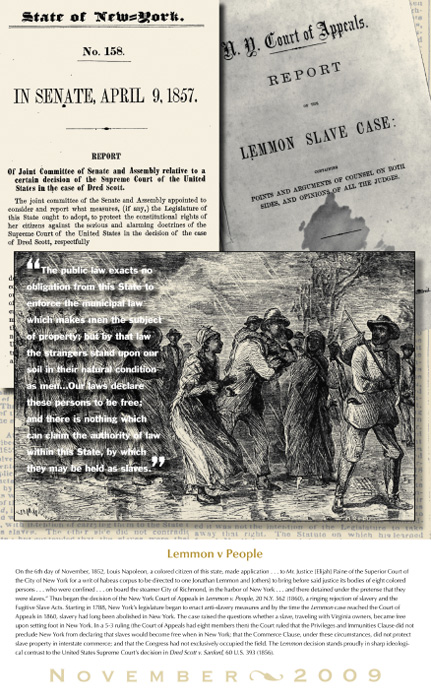
Lemmon v People
‘On the 6th day of November, 1853, Louis Napoleon, a colored citizen of this state, made application. . .to Mr. Justice [Elijah] Paine of the Superior Court of the City of New York for a writ of habeas corpus to be directed to one Jonathan Lemmon and [others] to bring before said justice its bodies of eight colored persons. . .who were confined. . .on board the steamer City of Richmond, in the harbor of New York. . .and there detained under the pretense that they were slaves.’ This began the decision of the New York Court of Appeals in Lemmon v. People, 20 N.Y. 562 (1860), a ringing rejection of slavery and the Fugitive Slave Acts. Starting in 1788, New York’s legislature began to enact anti-slavery measures and by the time the Lemmon case reached the Court of Appeals in 1860, slavery had long been abolished in New York. The case raised the questions whether a slave, traveling with Virginia owners, because free upon setting foot in New York. In a 5-3 ruling (the Court of Appeals had eight members then) the Court ruled that the Privileges and Immunities Clause did not preclude New York from declaring that slaves would become free when in New York; that the Commerce Clause, under these circumstances, did not protect slave property in interstate commerce; and that the Congress had not exclusively occupied the field. The Lemmon decision stands proudly in sharp ideological contrast to the United State Supreme Court’s decision in Dred Scott v. Sanford, 60 U.S. 393 (1856).
December 2009
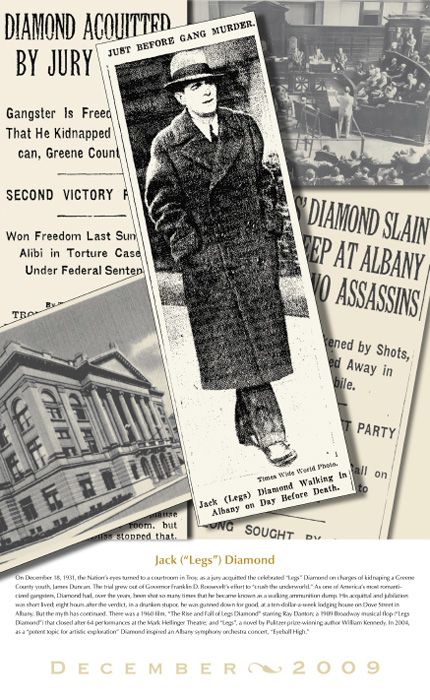
Jack ‘Legs’ Diamond
On December 18, 1931, the Nation’s eyes turned to a courtroom in Troy, as a jury acquitted the celebrated ‘Legs’ Diamond on charges of kidnaping a Greene County youth, James Duncan. The trial grew our of Governor Franklin D. Roosevelt’s effort to ‘crush the underworld.’ As one of America’s most romanticized gangsters, Diamond had, over the years, been shot so many times that he became known as a walking ammunition dump. His acquittal and jubilation was short lived; eight hours after the verdict, in a drunken stupor, he was gunned down for good, at a ten-dollar-a-week lodging house on Dove Street in Albany. But the myth has continued. There was a 1960 film, ‘The Rise and Fall of Legs Diamond’ starring Ray Danton; a 1989 Broadway musical flop (‘Legs Diamond’) that closed after 64 performances at the Mark Hellinger Theatre; and ‘Legs’, a novel by Pulitzer prize-winning author William Kennedy. In 2004 as a ‘potent topic for artistic exploration’ Diamond inspired an Albany symphony orchestra concert, ‘Eyeball High.’

